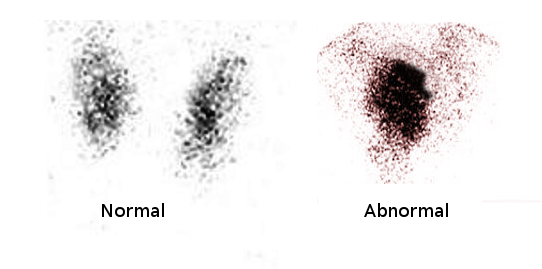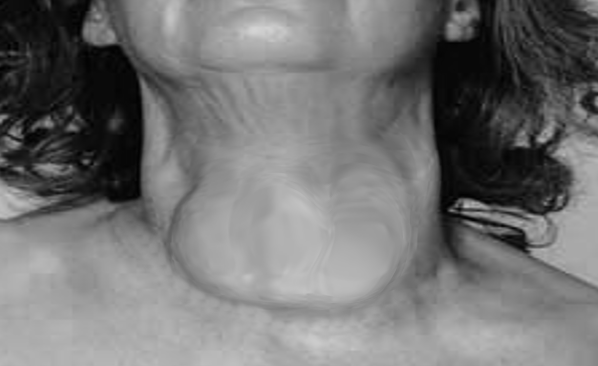Continuing Education Activity
Goiter is an anatomical enlargement of the thyroid gland. It can be related with thyroid dysfunction or have normal thyroid function. This activity review the evaluation, and treatment of diffuse toxic goiter and explains the role of the interprofessional team in evaluating and patients with this condition.
Objectives:
Identify the etiology of diffuse toxic goiter medical conditions and emergencies.
Assess the appropriate evaluation of diffuse toxic goiter.
Evaluate the management options available for diffuse toxic goiter.
Communicate interprofessional team strategies for improving care coordination and communication to advance the care of diffuse toxic goiter and improve outcomes.
Introduction
Goiter refers to the enlargement of the thyroid gland. It can be due to various causes, with dietary iodine deficiency being the most common cause worldwide. In the United States, however, Graves disease and Hashimoto disease are the most commonly seen in clinical practice. The goiters have been classified in different categories, as per morphology (described as nodular versus diffuse), functional status (that could be hyperthyroid, hypothyroid, or euthyroid), the presence of malignancy, etc. By definition, a diffuse toxic goiter is a diffusely hyperplastic thyroid gland that excessively overproduces the thyroid hormones. See Image. Toxic Nodular Goiter.
Etiology
The following are potential commonly seen causes of goiter development:
- Iodine deficiency [1]
- Autoimmune disorders [2]
- Smoking
- Hereditary pattern [3]
- Medications like lithium, iodides, and interferon-alpha [4], among others
- Radiation therapy [5]
- Inflammation and infections
Epidemiology
Graves disease is the most common cause of diffuse toxic goiter. It is also the most common cause of hyperthyroidism in the United States and worldwide, affecting 1 in 200 people. It usually affects people between 30 and 50 years of age but can occur in any age group. It is 7 to 10 times more common in females than males (see Image. Goiter in a Female). A marked increase in familial incidence has also been observed.
Pathophysiology
Diffuse toxic goiter is a diffusely enlarged vascular gland with a rubber-like consistency. Microscopically, the follicular cells are hypertrophic and hyperplastic with little colloid in them. Lymphocytes and plasma cells infiltrate into the gland and can ultimately aggregate into lymphoid follicles. All cases of diffuse toxic goiter are not Graves disease, and there may be various non-autoimmune causative processes, although the majority of cases are autoimmune. In Graves disease, antibodies are directed toward the thyroid-stimulating hormone receptor, which is present in thyroid follicular cells. The chronic stimulation of these receptors results in the production of excess amounts of T3 and T4 hormones and causes the enlargement of the thyroid gland, which eventually results in a goiter.[6]
Histopathology
This disease has the following histological characteristics:
- Diffuse non-nodular enlargement of the gland with a smooth capsule and increased vascularity.
- Hyperplasia of both follicular and papillary cells with lymphocytic infiltration into the stroma of the thyroid gland
- Follicular cells can also be enlarged and, in extreme cases, have enlarged nuclei mimicking that of papillary thyroid carcinoma. In Graves disease, however, they tend to maintain their rounded shape and have minimal clearing.
Due to the last point above, there have been controversies regarding the association between Graves disease and papillary thyroid carcinoma and whether the coexistence of the two affects the prognosis. On systematic review of various studies, it has been seen that if a papillary carcinoma is discovered after surgical removal of the gland, the prognosis is excellent, whereas when discovering a tumor in a patient with Graves disease, the local characteristics of the tumor (like the size, extent, margins, functionality, etc) most probably decide the final prognosis.[7][8]
History and Physical
History
Patients may present with a history of one or more consequences of a hyperthyroid state. These include weight loss, heat intolerance (with other heat-related symptoms like polydipsia and sweating), tremors, nervousness, anxiety, fatigue, palpitations, shortness of breath, frequent defecation or diarrhea, nausea, vomiting, etc. Patients may also complain of an obvious neck swelling or sensation of a lump in the neck, globus, swallowing difficulty, orthopnea, etc. Patients with Graves disease may present with additional features like:
- Ophthalmopathy, known as Graves orbitopathy (seen in 25% of patients), includes proptosis, diplopia, periorbital edema, excessive lacrimation, etc.
- Thyroid dermatopathy (rare, only seen in 4% of patients, and usually concurrent with orbitopathy) presents with slightly thickened pigmented skin, especially over the pretibial area.
- Abnormalities of the reproductive system, most frequently presenting as irregular menstruation.[9]
Physical Examination
The most commonly described findings in a patient with the diffuse toxic goiter on physical exam are as follows:
- Constitutional: weight loss
- Head, eyes, ears, neck: neck swelling with occasional audible bruit, proptosis, lid lag, periorbital edema, exophthalmos
- Cardiovascular system: tachycardia, irregular heartbeat, systolic hypertension
- Neuromuscular: tremor of extremities, hyperreflexia, hyperactivity, muscle weakness
- Respiratory system: shortness of breath or tachypnea
- Skin and extremities: moist and warm skin, sweaty hands, pretibial myxedema
Evaluation
The primary evaluation of the toxic diffuse goiter consists of a complete thyroid profile, including serum T3, T4, and TSH levels. The serum TSH is the best screening test for evaluating thyroid hormone excess or deficiency.[10] In the case of diffuse toxic goiter, the above tests usually result in low or marginally low normal TSH levels with elevated peripheral serum thyroid hormone levels. Based on preferences per population characteristics, socioeconomic reasons, and cultural backgrounds, the modalities of evaluation of the cause of thyrotoxicosis can either be radioactive iodide uptake or a combination of thyroid ultrasound with TSH-receptor antibodies.[9] A high radioactive iodine uptake diffusely depicts Graves disease, as does an enlarged gland with positive TSH-receptor antibodies (TRAb).
Treatment / Management
The treatment modalities for diffuse toxic goiter include:
Antithyroidthyroid Drugs (ATD)
- The antithyroid drug options are propylthiouracil, methimazole, and carbimazole.
- The American Thyroid Association and American Association of Clinical Endocrinology recommend methimazole as the preferred drug for Graves disease, except in patients with adverse reactions to the drug or women in the first trimester of pregnancy. It is preferred over propylthiouracil due to better efficacy, longer half-life and duration of action, and ease of dosing once a day.
- There are two different regimens to administer ATDs. The first is titration, where the dose of ATD is tapered to the lowest possible dose when the euthyroid state is achieved. The second regimen is based on the block-and-replace method, where a high dose of ATD is given adjunct with thyroxine replacement to maintain a euthyroid state ultimately.[11]
- A drawback of ATD therapy is the risk of recurrence, especially in the first year after stopping therapy. Studies reported a 50% to 55% risk of recurrence, with poor prognostic factors pointing to this direction, including severe hyperthyroidism, large goiter, high T3: T4 ratios, persistently suppressed TSH, and high baseline concentrations of TRAb.[12][13][14]
- Rare but major side effects of ATD therapy include agranulocytosis, hepatotoxicity, and vasculitis.
Radioactive Iodine Therapy (I-31, RAI)
- RAI is the commonest modality to treat Graves disease in the United States, and it is a very safe and effective form of treatment.
- The absolute contraindications of this therapy include pregnancy, breastfeeding, and severe uncontrolled thyrotoxicosis.
- It can be administered in liquid or capsule forms, and fixed-dose therapy is as effective as calculated dose therapy based on the gland volume, iodine uptake, etc.
- Patients must discontinue all iodine-containing medication and be on an iodine-restricted diet to ensure effective uptake of RAI.
- ATD therapy needs to be discontinued, preferably a week before the use of RAI, and it can be resumed a few days after administering RAI if needed.
- Potential side effects include the risk of developing hypothyroidism and, on rare occasions, transient radiation-induced hyperthyroidism or worsening of thyroid-associated ophthalmopathy (TAO).
- While hypothyroidism is actively screened at subsequent follow-ups, prednisone can be used to prevent the progression of mild TAO.
- Patients have to be counseled about lifelong follow-up for either disease recurrence or for the development of hypothyroidism, and they benefit from prompt treatment if diagnosed with either abnormality.[13]
Surgery
- Thyroidectomy is the most successful form of therapy for a diffuse toxic goiter, with total thyroidectomy being more successful than sub-total thyroidectomy with equivalent side effects.
- Due to the side effects associated with the use of general anesthesia, recurrent laryngeal nerve palsy, vascular complications, and hypothyroidism, surgical intervention is usually the last line of treatment.
- It is preferred in patients who are unable to tolerate antithyroid medications or RAI treatment or in patients with compressive symptoms due to a bigger size of the goiter.[15]
Differential Diagnosis
Although diagnosed through the various forms of evaluation, as described in detail above, the differential diagnosis of diffuse toxic goiter includes:
- Thyrotoxicosis factitia with overprescription or consumption of thyroid hormones
- Subacute or acute thyroiditis
- Multinodular goiter
- TSH secreting pituitary adenoma
- Iatrogenic iodine supplementation
Prognosis
Patients with diffuse toxic goiter, especially due to Graves disease, are expected to become hypothyroid during the natural course of their disease regardless of treatment. Prolonged thyrotoxicosis may cause ventricular thickening and, therefore, an increased risk of cardiac morbidity and mortality. Treatment with RAI is done with the aim of permanent hypothyroidism, thus making the patient dependent on lifelong thyroid hormone supplementation. ATDs have an average remission rate of 50% but an excellent prognosis after 4 years, devoid of relapse.[16]
Complications
The complications that can manifest with diffuse toxic goiter are as follows:
- Hyperthyroidism, or thyroid storm, due to prolonged untreated excess of thyroid hormone
- Cardiac arrhythmias and congestive heart failure
- Rare liver pathology, including fibrosis [17]
- Dermatopathy, mostly associated with Graves disease
- Graves ophthalmopathy
Consultations
Patients with diffuse goiters are advised to be evaluated by endocrinologists to undergo more detailed testing. Teamwork between primary care physicians, radiologists, surgeons, and endocrine specialists should be coordinated to achieve better outcomes. Pharmacists should also counsel the patients on the potential side effects of the medications used for their treatment so they can be aware of the findings and report them to their doctors promptly. Treatment approach steps should be discussed in advance, and the patients should be provided with details of the expected advantages versus disadvantages of the different treatment choices. On several occasions, the physicians caring for those patients must communicate closely to prepare the patients for the next steps to guarantee better compliance and results.
Deterrence and Patient Education
Diffuse toxic goiter may present with the usual hypermetabolic (like, for example, heat intolerance, sweating, weight loss, etc) and adrenergic symptoms (in particular the palpitations, tremors, emotional lability, etc) of hyperthyroidism, along with the swelling of the goiter. On the other hand, elderly patients may not present with adrenergic symptoms but rather with apathy and atrial fibrillation, which might also represent symptoms of depression, malignancy, or cardiac abnormalities.
Pearls and Other Issues
Although many cases of diffuse goiter remain asymptomatic, patients who notice an enlarged thyroid should be referred for specialty evaluation to investigate the gland's function while the anatomy is examined in more detail. Blood tests focusing on thyroid hormone levels and a neck ultrasound are the easiest starting points, and depending on the findings, further testing can be pursued, as explained earlier.
Enhancing Healthcare Team Outcomes
Diagnosing diffuse toxic goiter is an amalgamation of clinical signs and investigations. Evaluating radiological and blood tests is important in concluding the underlying cause of the disease. Once diagnosed, it is the physician's responsibility to help the patient pick the best treatment option based on their profile and with a thorough understanding of potential side effects. Women need to be especially careful and well-informed as while being pregnant or breastfeeding, they may be required to change their form of therapy. Since this condition can also lead to cosmetic concerns (like the bulging of the neck or eventually the eyes, etc) all physicians need to be sensitive and perceptive to them and counsel the patients about treatment options available, along with having a realistic approach to the treatment response.


